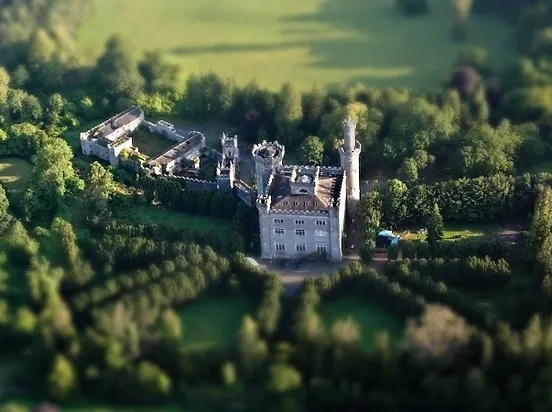Exploring The Rock of Cashel
Exploring The Rock of Cashel: History, Highlights, and Visitor Tips
the history of the Rock of Cashel is a rich tapestry that reflects the complexities of Ireland’s past, encompassing legend, conquest, faith, and culture over more than a millennium.
Legend traces the origins of the Rock of Cashel to a time when St. Patrick, the patron saint of Ireland, visited the King of Munster, Aenghus, According to tradition, St. Patrick used a shamrock to explain the concept of the Holy Trinity to Aenghus, thus converting him to Christianity. The legend of St. Patrick’s visit and the creation of the Rock of Cashel reflects the deep intertwining of Christian faith and Irish identity. Legend has it that during this encounter, St. Patrick inadvertently struck his pastoral staff into the ground, creating the limestone outcrop that would become the foundation of Cashel’s significance.
The Rock of Cashel, perched on a dramatic outcrop of limestone in the Golden Vale, is indeed one of Ireland’s most iconic and historically significant sites. Its impressive cluster of medieval buildings offers a glimpse into Ireland’s rich architectural and cultural heritage. Among the monuments to be found, there is a round tower a place of refuge during times of attack, and a symbol of the site’s Christian heritage, a high cross, a Romanesque chapel, a Gothic cathedral, an abbey, the Hall of the Vicars Choral, and a fifteenth-century Tower House.
It served as the Kings of Munster’s seat for centuries, symbolizing their power and authority. In the 4th century, the Eóganachta dynasty, one of the most powerful Gaelic Irish dynasties, Under their leadership, Cashel flourished as a hub of Gaelic civilization, with the dynasty’s influence extending far and wide across the island, established their rule over Munster from Cashel. Cashel’s rise to prominence as a stronghold of the Kings of Munster played a pivotal role in shaping the political landscape of Ireland.
One of the most notable events in Cashel’s history occurred in 978 when Brian Boru, one of Ireland’s most famous kings, was crowned High King at Cashel. Brian Boru’s coronation at Cashel solidified the site’s importance as a political and religious center, elevating its status as a symbol of royal authority and unity among the Irish kingdoms.
The round tower, believed to date back to the 9th or 10th century, is one of the oldest structures on the Rock of Cashel. Standing tall and imposing, the round tower served multiple functions throughout its history. It functioned as a bell tower, allowing monks to summon the faithful to prayer, and as a place of refuge during times of attack or invasion. Its sturdy construction and strategic position made it a vital element of the site’s defenses, attesting to the turbulent times in which it was built. The high cross, with its intricate carvings depicting biblical scenes and Celtic motifs, stands as a testament to the Christianization of Ireland.
In 1101, the grant of Cashel to the church marked a significant turning point in its history, propelling it to prominence as one of Ireland’s most important centers of ecclesiastical power.
the transition of ownership of Cashel to the church in 1101 solidified its status as a center of ecclesiastical power and set the stage for ambitious building projects that would enhance its prestige and importance. The transition of ownership solidified Cashel’s status as a center of ecclesiastical power. The church, with its newfound control over the site, embarked on ambitious building projects, including the construction of Cormac’s Chapel and the Gothic cathedral, further enhancing Cashel’s prestige and importance. Among the most notable of these projects were the construction of Cormac’s Chapel and the Gothic cathedral, both of which stand as enduring testaments to the architectural and artistic achievements of medieval Ireland.
the surviving buildings at the Rock of Cashel are remarkable for their architectural beauty, historical significance, and artistic richness. Cormac’s Chapel, in particular, stands out as a treasure trove of medieval art and craftsmanship.
the Rock of Cashel stands as one of Ireland’s most breathtaking and iconic landmarks, captivating visitors from around the world with its historic significance and architectural splendor.
By Author Raihan From NR EMEARALD DIARY
Published: August – Last updated: August 02, 2024

Nestled away in the County Cork countryside, just outside the city
Indeed, Kilkenny Castle is steeped in the history of the powerful Butler family, whose influence reverberated throughout Ireland for centuries. Nestled in Ireland’s heart, Blarney Castle is a testament to centuries of rich history, romance, and enchantment.

Charleville Castle: Everything You Need to Know About Charleville Forest Castle
Charleville Castle, situated in Tullamore, County Offaly, stands as a breathtaking example of Gothic Revival architecture set amidst the serene beauty of an ancient oak forest. A stunning example of Gothic Revival architecture, this castle is hauntingly beautiful.

Nestled away in the County Cork countryside, just outside the city
Indeed, Kilkenny Castle is steeped in the history of the powerful Butler family, whose influence reverberated throughout Ireland for centuries. Nestled in Ireland’s heart, Blarney Castle is a testament to centuries of rich history, romance, and enchantment.

Charleville Castle: Everything You Need to Know About Charleville Forest Castle
Charleville Castle, situated in Tullamore, County Offaly, stands as a breathtaking example of Gothic Revival architecture set amidst the serene beauty of an ancient oak forest. A stunning example of Gothic Revival architecture, this castle is hauntingly beautiful.


3 Responses